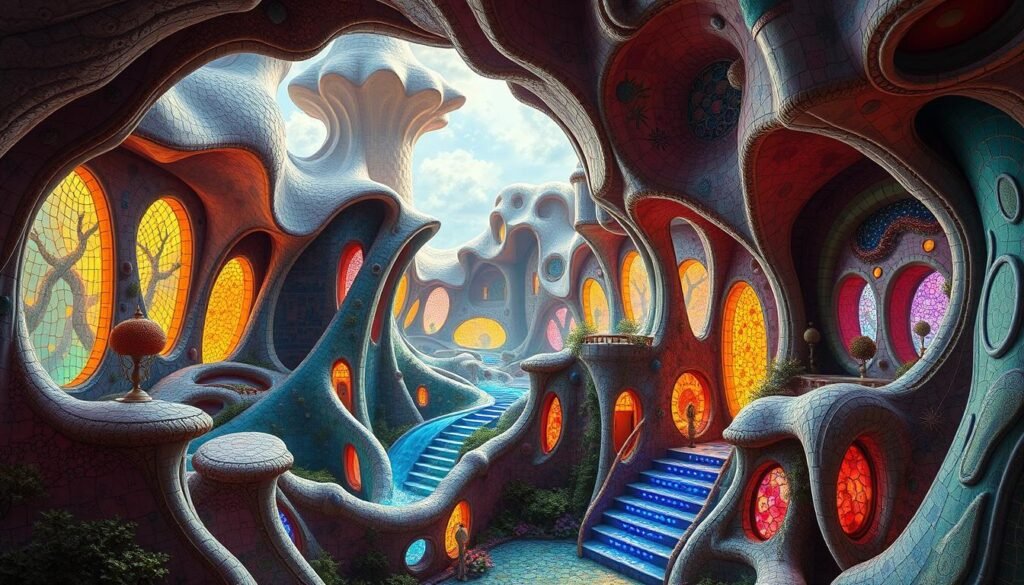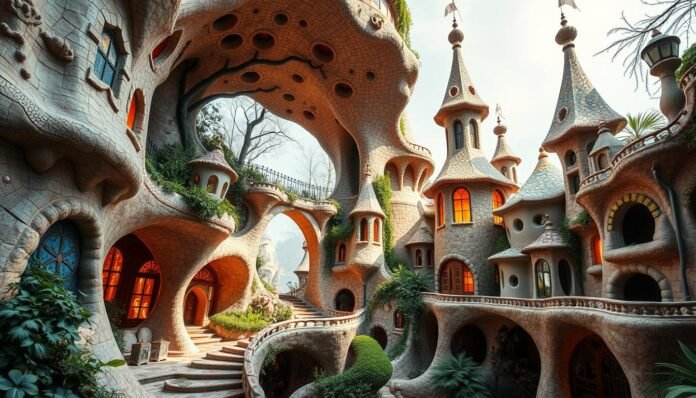Antoni Gaudí, a legendary architect, changed Barcelona forever. His visionary designs brought a new look to the city. He mixed organic shapes and bright colors in his work. This mix is a feast for the eyes. It invites us to find hidden beauty in urban art illusions.
Gaudí’s love for the unseen is clear in his work. His creations show a deep love for nature. They reflect Barcelona’s modernism. Places like the Sagrada Familia draw millions each year. They prove Gaudí’s lasting influence on architecture. Exploring his work, we find deep connections between buildings and the natural world.
Key Takeaways
- Gaudí’s art continues to inspire modern architects.
- Barcelona’s landscape is forever transformed by Gaudí’s creations.
- The Sagrada Familia welcomes about 2.8 million visitors annually.
- Casa Batllo is recognized as a UNESCO World Heritage site.
- Gaudí’s architectural period from 1900 to 1909 produced numerous symbolic works.
- He employed diverse materials like stone, ceramic, and glass in his iconic designs.
Introduction to Antoni Gaudi’s Visionary Architecture
Antoni Gaudí was a groundbreaking architect from Catalonia, Spain, born on June 25, 1852. He mastered craftsmanship and artistry early on. This foundation led to his unique architectural style. In his studies at the Barcelona School of Architecture, he dove into catalan modernism. His work combines tradition with innovation, captivating people all over the world.
Antoni Gaudi: A Brief Biography
In 1870, Gaudí moved to Barcelona, where his journey of creativity began. Despite doubts from his director, he graduated in 1878 and became a famous Spanish architect. He overcame many obstacles, like financial issues and early lack of recognition. Yet, his masterpieces like the Sagrada Familia and Casa Batlló stand as icons of creativity and innovation.
Innovation in Catalan Modernism
Gaudí’s work showcases the essence of catalan modernism, with its unique and natural designs. He used materials like parabolic arches and trencadís tiles in groundbreaking ways. The architect Antoni Gaudí is famed for his buildings that are both functional and beautiful. His work represents a huge step forward in architectural design.
| Event | Date | Description |
|---|---|---|
| Birth | June 25, 1852 | Antoni Gaudí was born in Catalonia, possibly in Reus or Riudoms. |
| Graduation | 1878 | Completed studies at the School of Architecture in Barcelona. |
| World Fair Exhibition | 1888 | Displayed his work at the World Fair in Barcelona. |
| Death | June 10, 1926 | Gaudí died after being struck by a tram in Barcelona. |
Gaudi Art and the Invisible: Unveiling the Unseen
Gaudi art gives us glimpses into nature in ways we didn’t see before. His designs go beyond just looking nice. They blend buildings with nature beautifully. This mix makes us feel like we’re talking with the environment itself.
Unique Aspects of Gaudi’s Creations
Gaudi’s work is full of special elements. You’ll find smooth curves and bright colors. Places like the Sagrada Familia show his deep love for nature. His buildings feel like surreal art installations. They remind us of art hidden in nature. Gaudi’s style shows there’s more to things than meets the eye.
His work makes us look closer to find the unseen. The idea that ‘less is more’ in creativity is seen in his buildings. This concept gets a nod in Dr. Nicomedes Suárez-Araúz’s art theory. For more insights, check out José Rodeiro’s thoughts.
Connection to Nature
Gaudi’s connection to nature is clear in his work. His buildings reflect nature, from tree shapes to water flows. They draw you into an eco-friendly world. Stacy Levy’s Diatom Lace in New York does something similar. It mimics the East River’s water patterns.
Gaudi bridges the gap between man-made and natural. Both his and Levy’s projects show art influenced by unseen ecosystems. Gaudi inspires us to find balance. He shows that art and sustainability can bring out the beauty in city life.

The Impact of Symbolism in Gaudi’s Work
Antoni Gaudí’s buildings are more than just pretty. They hide symbols that make you think deeper. These symbols mix art with hidden meanings, touching personal and worldwide stories. Every little detail in Gaudí’s work shows his deep beliefs, culture, and love for nature.
Hidden Symbolic References
Gaudí filled his works with many symbols. These include Christian, mythological, patriotic, and some misunderstood ones. Experts like Joan Bassegoda have explored these secrets, finding links to the Bible and Greek myths. Nature was his muse, showing up in his use of animal and plant designs that also had a religious twist.
The cross is a key symbol in Gaudí’s work. It pops up in many ways, from stained glass to building parts. This shows Gaudí’s strong faith and his connection to his religion.
Subtlety in Design
Gaudí mixed old and new in his architectural style. He took cues from Gothic art, like its soaring heights and colorful glass. This style shines in famous buildings like the Sagrada Familia. Here, Gaudí’s vision of theology comes to life.
At Casa Batlló, the facade is alive with colors. It uses small ceramic tiles, mimicking the look of water. This fun use of color plays with the idea of what’s seen and not seen. It lets people see architecture in a new way, connecting on different levels.
| Symbol Type | Description | Examples |
|---|---|---|
| Christian | References to biblical themes and faith. | Cross motifs, Sagrada Familia’s stained glass. |
| Mythological | Inspiration from ancient myths. | Greco-roman influences seen in design elements. |
| Patriotic | Expressions of cultural pride and identity. | Symbolism relating to Catalonia in several works. |
| Misunderstood | Incorrect interpretations of his designs. | False symbols arising from public misconceptions. |
Gaudí’s secret symbols and design choices make his work special. They turn buildings into an experience. By looking closer, you see stories of faith and culture. This makes Barcelona’s architecture something to truly admire.
Exploring Iconic Works of Gaudi
Antoni Gaudí was a famous architect from Spain. He made several iconic buildings that show how creative he was. His works combine natural shapes with new techniques. They look like surreal art pieces, breaking normal design rules. These structures let us see how architecture and nature can live together beautifully.
The Sagrada Familia: A Monument of Faith
The Sagrada Familia is one of Gaudí’s most famous works. It started in 1883 as a big faith and creativity project. The basilica has 18 spires for different religious figures.
Its facades and stained glass make it look magical. This building shows Gaudí’s art and hidden spiritual stories.
Park Guell: A Playground of Nature
Park Güell shows Gaudí’s love for mixing architecture and nature. It was supposed to be a place where people lived. It has curvy paths, bright mosaics, and natural shapes.
Its beautiful mosaics and fun designs make it a magical place. It helps us enjoy nature through Gaudí’s dreamy art works.
Casa Batlló: An Oceanic Masterpiece
Casa Batlló was finished in 1906 and is full of natural shapes and sea themes. This house makes you think of the ocean and shows Gaudí’s love for new ideas. Its wavy façade and bright colors showcase his unique style.
Casa Batlló is a great example of Gaudí’s art making us see the unseen. It tells stories that leave us amazed and thankful.
| Iconic Work | Year Completed | Notable Features | Location |
|---|---|---|---|
| The Sagrada Familia | Ongoing since 1883 | 18 spires, intricate facades | Barcelona, Spain |
| Park Güell | 1914 | Colorful mosaics, organic pathways | Barcelona, Spain |
| Casa Batlló | 1906 | Undulating façade, marine motifs | Barcelona, Spain |
Conclusion
Antoni Gaudí’s world takes us beyond beautiful visuals. It offers deep insights into the unseen in art. Works like Casa Batlló and the Sagrada Família show how architecture can unveil hidden art. This art deeply connects with us and the world around us. Each building is more than just innovative design. They tell the story of Gaudí’s endless dedication.
Gaudí merged art illusions with practical uses, making buildings come alive. He was inspired by nature and his faith. This brought a new life to concrete and stone. We see more than just buildings; we learn about deep truths they hold. The Sagrada Família is still being built, fascinating millions. It stands as evidence of Gaudí’s lasting impact.
Gaudí encourages us to see the unseen in our world. He connects architecture with the natural world in a deep way. His work doesn’t just beautify Barcelona. It also lights the way for future creativity and innovation in design and art.
